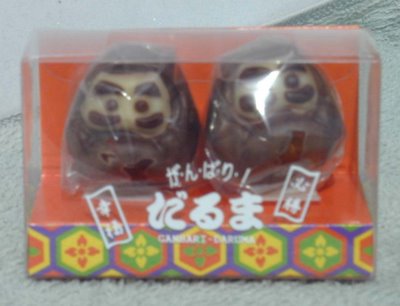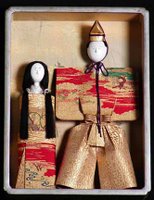:::::::::::::::::::::::::::::::::::::::::::::::::::::::::::::::::::::::::::::::::::::::::::::::::::::
Hina Matsuri, the Doll's Festival on March 3
雛祭りにだるま・ひなまつり

source : 門司ヶ関人形
Quote
If Daruma is at least an honorary doll festival participant (actually I've never seen him included in a Hina Matsuri display on the web or in person, but my experience is limited!) ...
Judy Shoaf
http://groups.yahoo.com/group/Darumasan-Japan/message/760
Last year I promised to find one, and now here he is, with his bride and all in chocolate.

:::::::::::::::::::::::::::::::::::::::::::::::::::::::::::::::::::::::::::::::::::::::::::::::::::::
In the Daruma Library:
The Hina Matsuri, by Alan Plate
Antique Japanese Festival Dolls, by Timothy Mertel
Hina Doll Festival (hina matsuri) and HAIKU
. Folk Art in Japan - Hina Dolls .
ooo ooo ooo ooo ooo
..... Japanese Dolls

http://www.lasieexotique.com/ningyo.html
:::::::::::::::::::::::::::::::::::::::::::::::::::::::::::::::::::::::::::::::::::::::::::::::::::::
Scroll with Daruma Hina Dolls
Painted by Ikawa Yoko
掛け軸-だるま雛/井川 洋光

© honakote.com
:::::::::::::::::::::::::::::::::::::::::::::::::::::::::::::::::::::::::::::::::::::::::::::::::::::
Hina Dolls from the Fukui Area.
these are from Nihonmatsu.
Darumabina だるま雛

© PHOTO : indymuseum
:::::::::::::::::::::::::::::::::::::::::::::::::::::::::::::::::::::::::::::::::::::::::::::::::::::
Tea cup with Daruma Hina Dolls
by the famous Kyoto potter Nonomura Ninsei
抹茶碗 仁清 達磨雛(だるまびな)


source : kakaku.ecnavi.jp
:::::::::::::::::::::::::::::::::::::::::::::::::::::::::::::::::::::::::::::::::::::::::::::::::::::


Click for more photos of Darumabina !

雛人形 だるま hina ningyo Daruma
:::::::::::::::::::::::::::::::::::::::::::::::::::::::::::::::::::::::::::::::::::::::::::::::::::::

Hina Doll Festival sweets and Daruma
from 舞来飴, 寶月堂 Fuugetsudoo, Fugetsudo
Photo curtesy of Kyoko Shibata, Facebook
New Year Sweets special
http://www.hougetudou.com/kisetu/syougatu/syougatu.html
:::::::::::::::::::::::::::::::::::::::::::::::::::::::::::::::::::::::::::::::::::::::::::::::::::::
Read more about Daruma san and Japanese Sweets, Dagashi
:::::::::::::::::::::::::::::::::::::::::::::::::::::::::::::::::::::::::::::::::::::::::::::::::::::

Off pedestal, Hina dolls take up ‘ordinary’ life
Traditionally, the dolls at the annual March 3 doll festival are displayed in tiers. But those currently on exhibit in Gujo, Gifu Prefecture, are acting out ordinary human activities, from drinking to washing. Some are even playing soccer.
The unique “performances” of some 2,000 Hina dolls have attracted visitors to this city since the exhibit began on Feb. 9. Organizers say the event is also revitalizing the business community and hope to make this a new winter tradition in this tourist city best known for its summer festival.
source : www.japantimes.co.jp / Feburary 2013
:::::::::::::::::::::::::::::::::::::::::::::::::::::::::::::::::::::::::::::::::::::::::::::::::::::

Magazine cover dated 1913.
- source : facebook
:::::::::::::::::::::::::::::::::::::::::::::::::::::::::::::::::::::::::::::::::::::::::::::::::::::
Read more details HERE
. WKD : Hina Doll Festival (hina matsuri 雛祭り)
. itobina 糸雛 string hina dolls .
Satsuma itobina 薩摩糸びな Satsuma string hina dolls
From Kagoshima, Miyazaki
. Folk Art in Japan - Hina Dolls .
:::::::::::::::::::::::::::::::::::::::::::::::::::::::::::::::::::::::::::::::::::::::::::::::::::::::::::::::::::::::::::
. - yookai, yōkai 妖怪 Yokai monsters - .

source : 門司ヶ関人形

In the year 1745 in the home of the Dainagon Nakayama 中山大納言栄親卿 one day there came all kinds of things and goods flowing into the house. Exorcism rituals did not stop these strange happenings and in autumn the Dainagon died. later the mysterious power (kai-i 怪異) moved on to the 毘沙門堂里坊 Bishamon hall. There, during the Hina Festival, the dolls began to laugh all day long.
In Miki town (Kagawa 香川県) there lived 三平 Sanpei san near Ninosaka 二ノ坂の焼き場.
The family always decorated the Hina dolls and talked to them.
One day the house burned down, but it seems that some strong force (お性根) had come to the house and saved the dolls, letting them roll out of the home.
- source : nichibun yokai database -
雛 24 to explore
棟上雛 / お雛様 / 烏の雛 / 雛鶴姫
:::::::::::::::::::::::::::::::::::::::::::::::::::::::::::::::::::::::::::::::::::::::::::::::::::::::::::::::::::::::::::
. Edo craftsmen 江戸の職人 shokunin .
hinaningyoshii, hina ningyoo shi 雛人形師 making Hina dolls

京の雛さま 江戸の雛さま
- quote -
Hina dolls are dressed like court nobles from the Heian period ...
..... tachi bina, or "standing dolls." in the Edo period ...
..... suwari bina, or "sitting dolls."
..... "Kanei bina" ..... "Genroku bina."
..... 次郎左衛門雛 "Jirozaemon" and the 有職雛 "Yusoku bina" - Representing the Orthodoxy of Court Culture
..... "Kokin bina"
- source and photos: kyohaku.go.jp/eng/dictio -
Making Hina dolls for the rich people of Edo was the job of some specialists.
Different craftsmen made the head, the body and the robes.
kashirashi, kashira-shi 頭師 makes the head of a Hina doll, the most important part, which gives the expression to a doll. The head was mostly made from the wood of paulownia (tooso 桐塑). The wood is made to powder (kiriko 桐粉) and then kneaded with natural glue. When the form is done, it is whitened by layering it with gofun whitewash powder. Finally the colors are added.
gofun 胡粉 is made from ground oyster shells or egg shells and special glue; it produces a shining, enameling white color for the surface of clay dolls.
. . . CLICK here for more Photos !
doo ningyo shi 胴人形師 makes the body of a doll, not only Hina dolls. He then adds the head, arms and legs. Sometimes these parts are fixed together, sometimes they can be taken apart for storage purposes.
kitsukeshi 着付師 puts the robes on the doll.
The body was usually padded up with straw and the robes had to fit over it.
. . . CLICK here for more Photos !
.......................................................................
. Yosa Buson 与謝蕪村 (1715-1783) .
- quote -
たらちねの抓まずありや雛の鼻
tarachine no tsuma mazu ari ya hina no hana
Mommy, first of all,
Should have pinched up,
The nose of a hina doll!
Background:
*The nose of a baby hina doll is not always well cut or prominent. Japanese children's noses are mostly flat. Mothers want them to be shapely, long, straight and elegant. So often they gently pinch up their children's noses while rearing them.
* 'Tarachine' means sometime 'a mother, one's mother', sometime 'a father' and‘one's parents’. In the Haiku naturally it means a mum or mom.
* ‘Tarachine no’ has been used since as early as the 8th century as a stylized epithet or a pillow word in tanka poems in phrases like ‘tarachine no haha (母) (mother)’ or ‘tarachine no oya (親) (parents)’.
* The phrase ‘Tarachine no tsuma’ in the Haiku means that its mother pinches up (something).
Impression:
A laughing is excited by the association of mother's way of bringing up her child through the personification of a baby hina doll: she pinches up their noses with a prayer in her heart for their getting shapely. Prof. Ogata and Mr. Takahashi comment the meaning of the Haiku is that 'the nose' of the hina doll should have been pinched up by its mother just like a living mother does.
Joys and sorrows in daily lives are important sources of haikai poems or haiku. The Poet is skilled in catching and weaving them into haiku, and makes them full of human touches.
- source : hokuoto77.com/buson-
.......................................................................

- - - - - Jirozaemon-bina
- quote -
Yusoku-bina Representing the Orthodoxy of Court Culture
At the time when Jirozaemon-bina was enjoying steady popularity, a new type of hina doll appeared in Kyoto. They were called Yusoku-bina as they were crafted by the yusoku method by which accurate historical evidence concerning the costumes of the court was ascertained. They were also known as Takakura-bina named after the Takakura family, the established connoisseur of yusoku knowledge who served the Imperial Palace.
Placing emphasis on the observation of historical facts, the Yusoku-bina was made very realistic in all respects, including the facial features. In terms of costume, ikan (simplified sokutai) or noshi of the court were often used rather than the sokutai (ceremonial dress). The fabrics were specially woven in accordance with court rank, age and the season, without being simply limited to gold brocade. For example, in the case of the noshi, the style for winter was selected as the Hina Matsuri and was held in March (of the lunar calendar). The costume was tailored based on the design for those under thirty years of age, by employing white with deep purple or red colored lining.
However, as these Yusoku-bina were originally produced for the nobility, they did not become popular among the general public. Nonetheless, they provided the later hina dolls with an example to follow concerning their realistic style.
- source : kyoto-shimazu.com/en -
:::::::::::::::::::::::::::::::::::::::::::::::::::::::::::::::::::::::::::::::::::::::::::::::::::::::::::::::::::::::::::
[ . BACK to WORLDKIGO . TOP . ]
[ . BACK to DARUMA MUSEUM TOP . ]
:::::::::::::::::::::::::::::::::::::::::::::::::::::::::::::::::::::::::::::::::::::::::::::::::::::::::::::::::::::::::::









5 comments:
Hina Doll Festival
Hina Matsuri and KIGO
http://worldkigo2005.blogspot.com/2005/04/doll-festival.html
nanban ningyoo 南蛮人形 Namban dolls of foreigners
and their hina doll versions 南蛮雛
.
Osaka, Sumiyoshi Shrine
quoting Mark Schumacher
Hina Matsuri 雛祭 or 雛祭り
Doll Festival, Girls' Festival
ALSO KNOWN AS THE
Snake Festival, Peach Blossom Festival,
or Drinking Around a Rolling Stream Festival
Origin = Japan, but with Chinese Antecedents
Japan's Doll Festival has a very curious history, one largely forgotten in contemporary times. Held annually on the first day of the snake on the third day of the third month in the old lunar calendar (March three in modern times) since the mid-to-late Edo period (1600-1867), it was originally a day for ritual purification known in Japanese as Jōshi no Sekku 上巳の節句 (literally “Seasonal Festival of the Snake”) when people would rub their bodies with crude human-shaped figurines made of paper, straw, clay or wood. These figurines served as “scapegoats” for taking on (exorcising) the spiritual pollution and bad karma of the devotee (see below). The word for snake (Jōshi) sounds like the word for girl (Joshi 女子), so the festival eventually became a day devoted to girls. Today the festival is a major joyous event but not a national holiday. Geared towards girls -- the first sekku 節句 (seasonal festival) after the birth of a baby girl -- it is a day when charming dolls are set out for display to symbolize the family's wish that their daughter will be healthy, free from calamity and able to obtain a happy life with a good husband. Also called the Peach Festival or Momo no Sekku 桃の節句, as March is the season when peach flowers are in bloom.
.
Check it out !
http://www.onmarkproductions.com/html/hina-matsuri-dolls.html
.
hina matsuri 雛祭と伝説 Legends about the Doll Festival
.
https://heianperiodjapan.blogspot.com/2020/03/hinamatsuri-doll-festival-legends.html
.
Hina dolls and hyootan 瓢箪 Hyotan gourd
hisagobina ひさご雛 Hisago Hina dolls
.
https://omamorifromjapan.blogspot.com/2014/05/hyotan-gourd-motives.html
.
Post a Comment